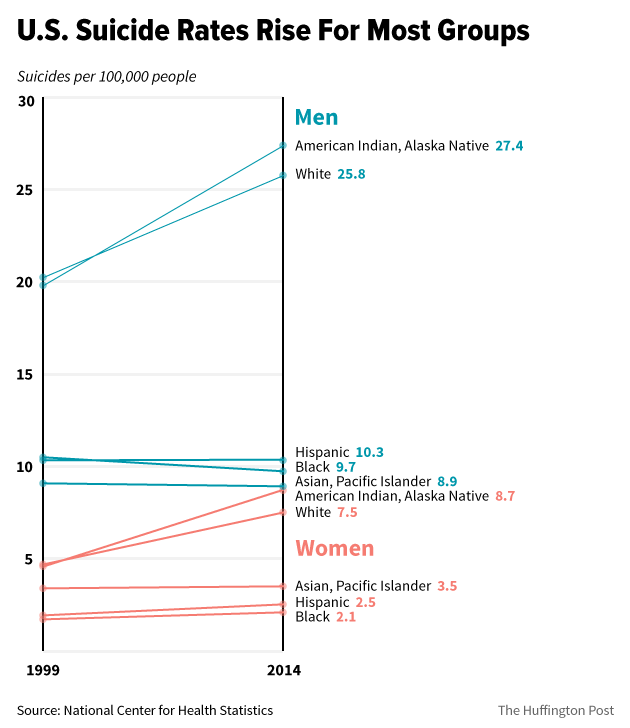

Suicide rates in the U.S. have increased 24 percent since 1999, with nearly 43,000 suicides in 2014, and the pace of the increase is rising, reports the Centers for Disease Control and Prevention (CDC).
Factors examined by various studies and media reports have linked suicide increases with rising debt and unemployment, depression due to economic and social issues, mental health issues, discrimination, poverty and social isolation. Teenage suicide “clusters” reported in the media have been linked to a rise in social media and cyberbullying.
Fred Goldstein describes how capitalists drive up profits at the expense of the workers in his Workers World article “Slowdown, unemployment plague world capitalism.” He identifies ways workers are becoming increasingly distressed: more work in less time for lower wages, below subsistence wages, burgeoning unemployment and exporting of jobs to oppressed countries where workers are paid even less. (April 23, 2015)
In her April 28 WW article “Verizon Workers Fight Back,” Kathy Durkin illustrates this current trend: “In the last decade, Verizon has cut its labor force by 40 percent. Workers hired after 2003 don’t have job security and now the company aims to eliminate the ‘no layoff’ clause for workers hired before then.” Verizon is outsourcing more jobs and attempting to reduce health care and disability benefits and freeze pensions.
A study called “Impact of business cycles on US suicide rates, 1928-2007” found “overall suicide rates generally rose during recessions and fell during expansions.” (pubmed.gov., June 2011)
The steepest increase among women was among the middle-aged, at 63 percent, says the CDC. Women face many economic hardships: They make only 79 cents for every dollar earned by men, and in middle age, they have a greater wage gap than that among younger workers. Also, single mothers make up one-quarter of U.S. households.
Suicide highest among Native Americans
The sharpest rise in the suicide rate was found among Indigenous people, an already very oppressed group. There was an 89 percent increase among Native women and a 38 percent rise among Native men.
Last April seven teens on the Pine Ridge Indian Reservation committed suicide; this tragedy followed four suicides in the Navajo Nation in Utah. The Center for Native American Youth at the Aspen Institute says the suicide rate is double the national average among Native youth ages 15-24. They have the highest rate of suicide of any U.S. population group, and that rate is growing. (Indian Country Today, Oct. 13)
During a United National Indian Tribal Youth conference, Native youth blamed “poverty entangled with a lack of jobs or access to mental health care for the high suicide rates, and federal government’s policies in the American Indian community made these conditions worse.” One youth said, “It’s kind of numbing, when there’s one every week. How do you address it?” (PBS Newshour, Sept. 30)
Monica Moorehead and Lamont Lilly, WW presidential candidates, wrote, “The economic crisis has exacerbated Native workers’ unemployment, and high jobless rates continue. With bleak futures, one-half of Native youth drop out of high school. … At least one-third of Native people are impoverished.” Also, “Indigenous women and men, 1 percent of the population, make up nearly 2 percent of those killed by police.” (WW, Nov. 25)
Suicide and young people
The CDC study showed that the suicide rate tripled for 10- to 14-year-old females; there were 150 suicides in that group in 2014. That is the second highest cause of death among adolescents, with the greatest increases found among girls in this age group.
The Cyberbullying Research Summary found that 20 percent of middle-school students reported that they seriously thought of attempting suicide and that all forms of bullying led to increases in suicide. (Hinduja & Patchin, 2010)
The vast majority of LGBTQ youth face harassment and bullying, including physical violence, because of their sexual orientation, gender identity or gender expression. They are two to three times more likely to attempt suicide than other teens, says the Gay, Lesbian and Straight Education Network.
High school students face a bleak future, with fewer job opportunities, low wages, exorbitant college tuition and increased student debt. Since 1990, debt on student loans has increased to 74.3 percent of graduates’ annual earnings.
Veterans’ suicide
The U.S. Department of Veteran Affairs says there is a daily average of 22 suicides among Iraq and Afghanistan war veterans. Thousands of veterans suffer from untreated post-traumatic stress disorder and substance abuse. “People need to understand that the impact of war is significant on the human psyche,” wrote Carl Lewis in the Feb. 18 issue of WW.
High costs, lack of insurance and cutbacks in public mental health programs keep people in desperate need from accessing essential services, treatment and medications. Between 2009 and 2012, states cut $4.35 billion in public mental health funding. That 19 states still refuse to expand Medicaid is another barrier to accessing care.
By Alireza Salehi The following commentary first appeared on the Iranian-based Press TV at tinyurl.com/53hdhskk.…
This is Part Two of a series based on a talk given at a national…
Educators for Palestine released the following news release on July 19, 2025. Washington, D.C. Educators…
On July 17, a court in France ordered the release of Georges Abdallah, a Lebanese…
The following are highlights from a speech given by Yemen’s Ansarallah Commander Sayyed Abdul-Malik Badr…
Panamá Beluche is a sociologist, professor and anti-imperialist organizer in Panamá, writing here about the…